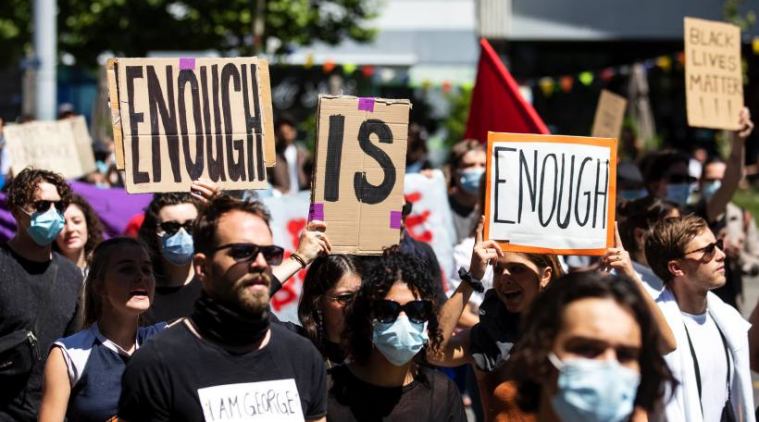 People demonstrate at a “Black Lives Matter” rally to mark the death of George Floyd in Zurich, Switzerland, Monday, 1 June 2020. (Representational image, courtesy: Alexandra Wey/Keystone via AP)
People demonstrate at a “Black Lives Matter” rally to mark the death of George Floyd in Zurich, Switzerland, Monday, 1 June 2020. (Representational image, courtesy: Alexandra Wey/Keystone via AP)
In the wake of the Black Lives Matter protests, luxury fashion brands have been called out for ‘hypocrisy’ in showing solidarity with the movement while perpetuating racism in the industry.
A while ago, the first black model for Vogue cover Beverly Johnson opened up on racism in the fashion industry. Recently, transgender model and actor Munroe Bergdorf reacted to L’Oreal’s #BlackoutTuesday posts, accusing the brand for having fired her about three years ago when she complained about racism in strong language.
Meanwhile, US actor Tommy Dorfman, who appeared in a recent campaign for Salvatore Ferragamo, called out the Italian luxury brand for what he called a “homophobic and racist work environment”.
To this, Ferragamo responded by saying, “No one is born hating another person because of the color of his skin, or his background, or his religion.”
Dorfman shot back that people at the fashion house “have said heinous, transphobic, body phobic and racist things directly to me. I called them out every time and they promised to change.”
Read| Diet Prada calls out problematic Vogue covers, including one featuring Deepika Padukone
As many fashion houses posted black squares on Instagram, netizens challenged them to do more than that — to make runways, magazine covers, boardrooms and creative studios living showcases of diversity.
“People have the fire under their bottoms. Their stories are strong and their voices are being heard. If the industry ignores them, they can be kept accountable. Everyone is sharing, and corroborating, their stories,” American content creator based in Milan Tamu McPherson, who collaborates with top luxury brands, was quoted as saying. “In seven years, I am still one of the only black people invited into those spaces. That is unacceptable,” McPherson, who has been working with luxury brands since 2013, added.
The pushback against the industry has already had some positive outcomes. Bergdorf, who was sacked as L’Oreal UK’s first openly gay transgender model in 2017 has now been appointed as a consultant on the UK Diversity and Inclusion Advisory Board to help influence and inform the brand. The offer came after she highlighted the company’s hypocrisy after it said that it “stands in solidarity with the Black community, and against injustice of any kind.”
The Fashion Spot, which has been conducting surveys since 2015, has also noted some progress in showcasing diversity on runways and magazine covers. The Spring 2020 season saw the highest level of diversity in four main fashion cities of Paris, Milan, New York and London, at 41.5 per cent, only to dip for the Fall 2020 shows, to 40.6 per cent. That remains an improvement from 17 per cent in the website’s inaugural survey for Spring 2015.
Luxury brands Gucci and Prada also announced long-term strategies last year to promote diverse voices that have not been properly represented in fashion, with scholarships. The announcement was made after they came under fire for designs that were deemed racist.
Vogue editor-in-chief Anna Wintour also apologised to her employees for not doing enough to elevate black professionals. This came as Samira Nasr was named the first editor-in-chief of colour in the 153-year history of US Harper’s Bazaar.
Supermodel Naomi Campbell, the first black woman to appear on the cover of French Vogue, is also publicly calling for equal pay for models of colour, besides more representation.
(With inputs from AP)